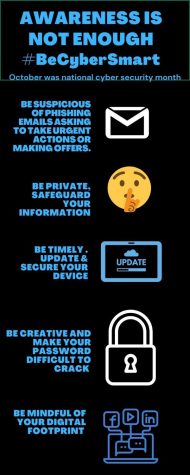
Cyberattacks are no longer an activity of high-profile companies and national security but have become a daily reality for schools. According to an FBI’s Alert, 57% of all reported ransomware attacks in August and September 2020 were targeted at the U.S. KŌĆō12 schools, and this is an increase from 28% for the period from January through July 2020. The average ransom was around $50,000, but the highest has crossed $1.4 million.┬Ā
Cyberattacks have hit schools and colleges harder than any other industry during the pandemic.┬Ā Two school districts in Missouri had to close due to ransomware attacks this summer.┬Ā
October was Cybersecurity Awareness Month and this yearŌĆÖs theme is ŌĆśDo Your Part. #BeCyberSmart.ŌĆÖ We can start with the question: what are we doing to keep our school safe from these cyberattacks?┬Ā
ParkwayŌĆÖs Chief Information Officer Jason Rooks is on the alert every minute to stop and mitigate cyberattacks as well as to provide teachers and students with safe, stable technology services.
ŌĆØIn such cases, someone from the outside used either a system vulnerability or a user account to access the district Information Technology (I.T.) infrastructure. Once they have access to the network they are able to extract data, deploy malware and encrypt systems,ŌĆ£ Rooks said. ŌĆ£I think the important thing we can learn from these attacks is that anyone is vulnerable.ŌĆØ┬Ā
School districts are at a high risk for cyberattacks due to a high volume of users that may lack security awareness, heightened use of technology and remote access during the pandemic and lack of resources to stop and mitigate attacks.┬Ā
ŌĆ£Protecting students and their data is meaningful work. School districts are especially vulnerable to attack due to a lack of resources. It creates a very unique challenge,ŌĆØ Rooks said.┬Ā
The end-user is the most common entry point for ransomware cyberattacks according to Rooks. End-users include all students, teachers, administrators, parents and everyone that is using the schoolsŌĆÖ computer systems and network.┬Ā
ŌĆ£Typically it will be someone who clicks on a phishing email and enters in their credentials. This gives the attacker an entry point into the network and an opportunity to compromise other systems, ŌĆ£ Rooks said.┬Ā
A typical phishing email tries to create a sense of urgency and asks to do something. Rooks says an example of a common phishing attack is when the attacker sends an email pretending to be a principal using a made-up email address such as headofschool@gmail.com. The attacker might say something in the email like ŌĆśAre you there? I really need you to email me.ŌĆÖ When the victim replies, they will ask the person to go to the store and buy gift cards. Then they will ask the victim to scratch off the back of the gift cards and email them the numbers to redeem the cards.┬Ā
ŌĆ£The goal is to create a sense of urgency so that the victim doesnŌĆÖt have time to think, ŌĆ£ Rooks said. ŌĆ£The whole time the victim thinks they are doing something to help the principal. This is a common attack and one we have seen be successful at Parkway. The easiest way to combat this attack is just to verify the source email address or pick up a phone and call the principal.ŌĆØ
Rooks encourages everyone to be skeptical of suspicious emails or websites and not to click on random website links.┬Ā
ŌĆ£Take the time to learn the basics of cyber security and programming. You donŌĆÖt have to be a programmer, but learning the basics will help you understand how the bad guys do what they do,ŌĆØ Rooks said.┬Ā
Although we hear about the attacks that have caused damage, there are many that are successfully blocked on a daily basis. There are a number of different tools that schools use that block activity identified as malicious, such as anti-malware applications, as well as regular scanning and reporting.┬Ā
ŌĆ£We once had an entity attempt to access our data warehouse, they were most likely based in eastern Europe or Russia. They gained access to a publicly facing server through a protocol that was left on by mistake. The entity then tried to launch an application to help them gain access to other directories and services,ŌĆØ Rooks said. ŌĆ£Fortunately, the language the application was written in was not supported on the server. Also, our advanced malware protection identified the malicious activity and blocked the application and the user. In the end, our protections worked the way they were supposed to.ŌĆØ┬Ā
One key to keeping yourself and the school cyber safe is to educate yourself on the basics of cybersecurity and understand how to protect yourself, according to Rooks. Senior and president of the Cybersecurity club Luc LaRocca, says the club aims to promote cyber security awareness by giving students the opportunity to compete in CyberPatriot, a competition run by the Air Force Association in which students evaluate virtual scenarios for security vulnerabilities and try to fix them.┬Ā
ŌĆ£I joined the Cybersecurity club because I was curious about how cyber-secure I was with my personal devices. I figured if I knew a thing or two about cyber security, then I could do this. I discovered that a lot of my accounts were at risk and that everyone can become more cyber secure,ŌĆØ LaRocca said.
LaRoccaŌĆÖs three big cybertips for students are to create secure passwords for every device including your phone, use two-factor authentication on accounts that offer it and never click on a link sent by an unknown source, including a bit.ly or TinyURL.
ŌĆ£A simple way to do this is to think of a statement that holds meaning to you, abbreviate that, and incorporate different characters, capitalizations and numbers into it,ŌĆØ LaRocca said. ŌĆ£ If that makes it too hard to remember, try using topics from an interest of yours. For example, if you like the TV show Friends, you could use jO3y_3b4n! for one account, and bpHe0b3! for another one. This helps you to remember your passwords but still be cyber secure.ŌĆØ
While cybercrime grows exponentially, we are facing a severe cybersecurity talent drought, according to Forbes. A Bureau of Labor Statistics report states that the rate of growth for jobs in information security is projected at 37% from 2012 to 2022. For students that may be interested in exploring or pursuing a career in cybersecurity, Parkway has offered a semester-long cyber security course since 2018 for all interested high school students through the virtual campus.
ŌĆ£A student interested in cybersecurity will have opportunities in both the public and private sectors,ŌĆØ Rooks said. ŌĆ£There are a ton of great opportunities in all areas of cybersecurity.ŌĆØ



![Gazing up from the stage, junior Joseph McCurdy who played Peter Pan in the school play, Lost Girl, sits next to senior Juliana Rogers, who plays Wendy Darling, during a theater rehearsal. McCurdyŌĆÖs passion for theater began when he observed a West High production in middle school. ŌĆ£I've been in the high school theater program since I was a freshman. I've always loved theater, but [what prompted me to join] was [when] I went to see [a performance here] when I was in middle school, and it was super cool,ŌĆØ McCurdy said.](https://pwestpathfinder.com/wp-content/uploads/2025/11/IMG_6535-1200x798.jpeg)

![Standing tall, stacked in a precise formation, the cheer team strikes a signature pose during halftime on Sept. 12 at the varsity football game. Nearly a month after this performance, the cheer team performed at the Missouri Cheerleading Coaches Association (MCCA) regional competition on Oct. 4, 2025. ŌĆ£We've all come [to] work together a lot more,ŌĆØ sophomore Elyssa Philippi said. ŌĆ£We're a lot closer than we were [earlier in the season] and going to state has made us closer [in] trying to work with each other, learn [new] skills and make our team better.ŌĆØ](https://pwestpathfinder.com/wp-content/uploads/2025/11/DSC5139-1.jpg)
![Handing out candy to excited trunk-or-treaters, President of the United Nations ChildrenŌĆÖs Fund club and junior Sara Ashok represents that group. Ashok was eager to participate in this event for multiple reasons. ŌĆ£I really wanted to be a part of the event because I get to help create memories for kids and spend time with my friends, spreading the things [I'm passionate about],ŌĆØ Ashok said.](https://pwestpathfinder.com/wp-content/uploads/2025/11/DSC_8648-1-1200x800.jpg)

![Smiling in a sea of Longhorns, Fox 2 reporter Ty Hawkins joins junior Darren Young during the morning Oct. 3 pep rally. The last time West was featured in this segment was 2011. ŌĆ£[I hope people see this and think] if you come to [Parkway] West, you will have the time of your life because there are so many fun activities to do that make it feel like you belong here. I was surprised so many people attended, but it was a lot of fun,ŌĆØ Young said.](https://pwestpathfinder.com/wp-content/uploads/2025/10/Edited2-1200x798.jpg)
![West High seniors and families listen as a representative of The Scholarship Foundation of St. Louis, Teresa Steinkamp, leads a Free Application for Federal Student Aid (FAFSA) workshop. This session, held in the library, provided guidance on financial aid, scholarships and student loan options. ŌĆ£This event is very beneficial for any seniors who are applying to or considering applying to colleges after high school [because] the cost of college is on the rise for seniors and parents,ŌĆØ college and career counselor Chris Lorenz said.](https://pwestpathfinder.com/wp-content/uploads/2025/09/DSC_4478-1200x778.jpg)
![Senior Kamori Berry walks across the field during halftime at the Homecoming football game on Sept. 12. During the pep assembly earlier that day, she was pronounced Homecoming Queen. ŌĆ£I thought it was nice that the crowd [started] cheering right away. I know [my friends] were really excited for me, and my family was happy because typically non-white people don't win,ŌĆØ Berry said.](https://pwestpathfinder.com/wp-content/uploads/2025/09/DSC7046-Enhanced-NR-1200x798.jpg)


